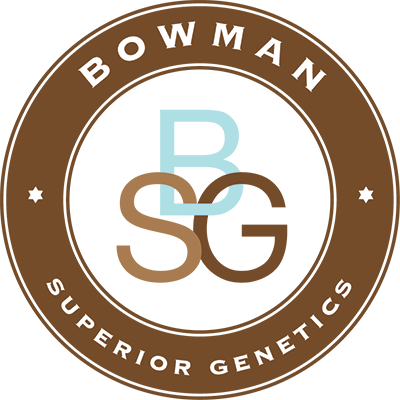What Are EPDs?
Expected Progeny Differences (EPDs) are a very important tool used in genetic selection at BSG. They are the ingredients to economic selection indexes, like $Durham or the suite of indexes published by breed associations on an animal’s genetic profile. EPDs are used to compare the differences in predicted performance of an animal’s offspring for specific traits important to cattle production. The calculation of EPDs is complex and driven by pedigree estimates, the individual’s performance data from within their contemporary group, and progeny performance data. The American Shorthorn association offers thirteen different EPDs for given traits measured.
Click on an EPD measurement below for details.
Calving Ease Direct (CED):
The most important EPD in sire selection for use on heifers. This value is expressed as a percent of unassisted births; the higher, more positive a number is most desirable.
Birth Weight (BW):
An indicator of predicted birth weight and calving ease, that is reported in difference in pounds. Large BW EPDs typically, but not always, indicate a potential for more calving difficulty and larger mature size.
Weaning Weight (WW):
Weaning weight measures the differences in weight of calves at weaning and is also reported in pounds. A higher WW EPD indicates a higher expected calf weight at weaning.
Yearling Weight (YW):
Like other weight traits, yearling weight measures the different in weight of animals at a year of age and is also expressed in pounds. A higher YW EPD indicates a higher expected weight at a year of age.
Milk (MK):
Milk EPD is the expected difference in a bull’s daughters’ calves at weaning weight due to their milking ability. Milk is how well the daughter’s milk and how that translates to the weaning weights of their calves. A higher MK EPD indicates a higher weaning weight due to the bull’s daughters’ milking ability.
Total Maternal (TM):
TM predicts the total difference in a weight of a bull’s daughters’ calves at weaning. A portion of this difference in weight comes from the milking ability of the bull’s daughters (MK EPD) and a portion comes from the genes for growth passed from the bull to his daughters and then on to their calves. The TM EPD is calculated by taking ½ of a bulls WW EPD + his MK EPD.
Calving Ease Maternal (CEM):
Calving Ease Maternal reflects a bull’s ability to sire daughters who calve progeny that come unassisted. The value is expressed as a percentage of unassisted births, with a higher, more positive number being more desirable.
Stayability (ST):
Stayability is a measure of the percentage of a bull’s daughters that will still be in the herd at six years of age. Like CED and CEM, Stayability is expressed as a percentage. A higher ST EPD indicates a higher percentage of daughters staying in the herd due to a multitude of traits (udder quality, structural correctness, fertility, docility, profitable production, etc.).
Yield Grade (YG):
YG EPD measures the differences in carcass yield ability. In the United States, beef carcasses are measured for Yield Grade 1 (highest yielding) to 5 (lowest yielding) scale. The YG EPD is expressed in units of points on the USDA’s Yield Grade scoring system. Animals with a more negative YG EPD are expected to produce progeny with carcasses that have lower yield grade score. However, over selection for YG EPD can lead to harder conditioning Shorthorns cows, since Shorthorns are already one of the industry’s best breeds for leaner carcasses.
Carcass Weight (CW):
expressed in pounds as a predictor of the differences in hot carcass weight of a sire’s progeny compared to progeny of other sires.
Marbling Score (MB):
evaluation of intramuscular fat deposition in the ribeye as expressed in USDA numeric marbling scores. Higher values indicate genetics that are expected to marble and have a higher quality grade.
Backfat (FT):
Fat thickness measures the amount of back fat on a carcass. FT is reported in inches. A lower FT EPD indicates a bull whose progeny will have less fat on the carcass than a bull with a higher FT EPD. Again, over selection for less fat can lead to harder doing cattle.
Ribeye Area (REA):
REA measures the difference in ribeye area of a bull’s progeny. REA is measured in square inches. A higher REA EPD is indicative of expected larger ribeyes.
If you look back at our books today, you’ll see that over our 30-year history only the strongest cow families have survived. If the cattle are not structurally, reproductively, or maternally sound, they have no place at our table. Producing stock which excel for the core traits encompassing maternal instinct, ability and efficiency are fundamental for us. Fertility and function are king at BSG.
Web links we find helpful...
(Check out the Sire Selection Manual and the Brown Bagger Series)
